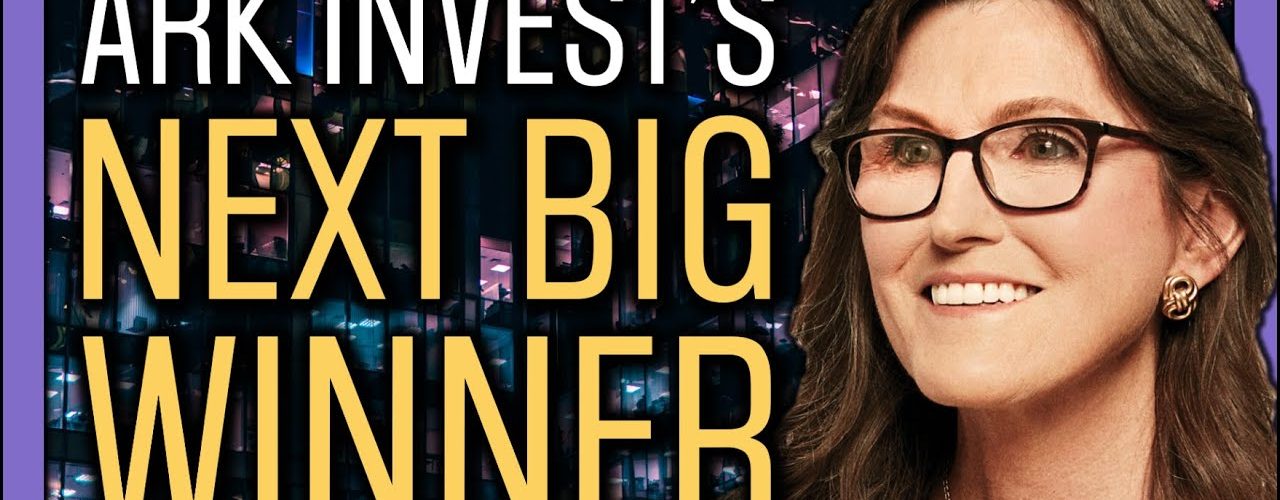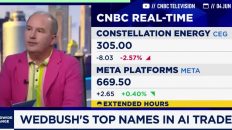Mentioned in Video:
- Inside Netflix’s Project Griffin: The Forgotten History Of Roku Under Reed Hastings: https://www.fastcompany.com/3004709/inside-netflixs-project-griffin-forgotten-history-roku-under-reed-hastings
- Roku stock sinks after company reports tight hardware margins, dramatic fall in streaming viewership (CNBC): https://www.cnbc.com/2021/08/04/roku-q2-2021-earnings.html
- A great analysis on Seeking Alpha: https://seekingalpha.com/article/4446029-revisiting-roku-after-a-near-20-percent-drop
- Support the channel and get extra member-only benefits by joining us on Patreon: https://www.patreon.com/tickersymbolyou
😲 #CathieWood just loaded up on #ROKU inside two of the biggest #ARKInvest funds – #ARKK and #ARKW. After digging into it, I realized that this stock could be like the #Tesla stock (#TSLA) of the #streaming industry. In this episode, I'll show you why @ARK Invest is loading up on Roku stock and how it could be one of the best stocks to buy now.
Video Transcript:
[00:00:00.250]
I'm starting to think that Roku might be the Tesla of television. Let me show you why. First off, Cathie Wood just loaded up on Roku stock, ticker symbol ROKU. Let's take a quick look at ARK Invest's most recent trading data. Here's a table of their positions inside ARKW, their fund themed around the next generation of Internet applications.
[00:00:19.510]
Each row in this table is one stock. The rows are ordered by the size of that stock's position in this fund, and each position is colored according to its change over the two most recent trading days. Yesterday alone, Cathie Wood increased Roku's share count in ARKW by over 22%, making it the 11th biggest position in this fund. Roku's share count increased by almost 12% in ARKK, ARK Invest's massive $23 billion flagship innovation fund, making it the third biggest position in that fund with over $1.3 billion in it.
[00:00:50.890]
If we take a look at the same table but for all of ARK Invest's funds combined, Cathie Wood is holding about 13% more Roku shares today than she was just one trading day ago, making it ARK Invest's fifth biggest position overall, with over one and a half billion dollars in it. Also note that this increase in Roku's position is bigger than Cathie Wood's increases in Tesla, Teladoc, Square and Shopify combined. So what happened? Well, I did a little digging, and in this episode I'll share a few key facts about Roku,
[00:01:20.410]
why I think Cathie Wood is loading the boat so aggressively with its stock and what I think the future holds for Roku's quickly growing market. Also, stick around till the end of the episode, and I'll tell you what I'm investing in as a result. Your time is valuable, so let's stream right into it. A lot of people don't realize this, but in 2007, Netflix almost launched a device called the Netflix Player, a box that subscribers could hook up to their televisions to stream movies and TV shows from the Internet.
[00:01:46.750]
Netflix executives knew that this could fundamentally change how the company delivered its content to its customers, who back then had to wait about three business days for DVDs to arrive by mail.
[00:01:56.830]
Can you imagine? At the end of 2007, right as the Netflix player was ready to launch, their CEO realized that if Netflix started shipping its own hardware, it would complicate any potential for partnerships with other hardware manufacturers like Apple. Shelving their player and staying hardware agnostic ended up being a great move for Netflix because it allowed them to become the dominant player in subscription streaming video. So Netflix spun out the Netflix Player project and the team as a separate company instead. That company is Roku, which is still led by their CEO, Anthony Wood, who was a former VP that left Netflix in 2007 when Roku was formed as a separate company.
[00:02:35.590]
About a year later, Roku's first player launched. It was called The Netflix Player. Pretty cool, right? My point here is that Roku was founded by people who really understand the present and future of television and streaming and came out of a company that's still dominating that landscape today. So let's talk about that landscape next. The global television market is massive. Today, there are well over a billion households with televisions, most of which have some form of paid subscription, whether it's a cable package or a streaming service.
[00:03:05.050]
The main way the average person consumes media today is still through linear TV, which is TV that you have to tune into at a specific time or else you'll miss your show. Linear TV represents something like 75% of the total TV time today with streaming representing the other 25%. But that trend is moving further and further away from linear TV each year, as more and more households are cutting the cord, and the pandemic has only accelerated that shift. I don't think anyone who cut the cord in the last few years is in a rush to resubscribe to cable TV once things return to normal, whatever that new normal actually looks like.
[00:03:41.410]
In fact, Roku believes that all television will one day be streamed and that every TV will have some form of operating system kind of like how every smartphone does today.
[00:03:50.830]
In my opinion, this is also a nobrainer longterm trend to bet on. Roku is trying to become the streaming platform that connects the entire TV ecosystem of viewers, content, publishers, and advertisers. The Roku operating system is purpose built for TV and designed to run on less powerful hardware, meaning TV makers who decide to use Roku's operating system can get away with less powerful chips and less memory. That means they can sell a smart TV for less money than if they went with one of Roku's competitors. As people keep moving to smart TVs and their overall entertainment budgets continue to shrink, Roku has become the number one operating system in that space.
[00:04:30.670]
In fact, about half of all of streaming hours on connected TVs are done through a Roku device. That's around 70% more than their next biggest competitor, which is Amazon's Fire TV, and around five times more than Apple TV. Almost four in ten TVs in the US today are shipped with Roku built into them. Another company that used this tactic to great success back in the day was Microsoft, who used to ship computers with Windows already installed on them at no extra cost. Video game consoles are also often sold at a loss because Sony and Microsoft know they're going to make it up with high margin digital offerings over time.
[00:05:07.570]
TV s with Roku installed on them are following that same kind of model.
[00:05:11.590]
In fact, in their most recent shareholder letter, which was published on August 4th, 2021, they said the chip shortage and pandemic related shipping constraints continue to increase costs faster than expected across all consumer electronics categories. As a result, Roku decided to insulate consumers from increased costs for their players, which resulted in player gross margin turning negative in the quarter. My point here is selling your hardware at zero profit or even at a loss to get into more households, really? Isn't that crazy? While I'm on the shareholder letter, let's talk about their Q2 numbers. Consumers sought increased out of home entertainment activities such as dining and travel. In Q2, as a result of the pent up demand and the loosening of pandemic restrictions, which led to a broader decline in overall TV viewing hours on a year over year basis, Roku significantly outperformed the industry, with Roku's streaming hours increasing nearly 19% globally, compared to a near 19% decline in traditional TV consumption and an average of a 2% decline in TV streaming across all other platforms.
[00:06:15.730]
So just like Tesla, ARK Invest's biggest position, Roku is growing at a time when most of their competitors are shrinking. And also like Tesla, Roku actually saw some insane growth numbers. Total net revenue grew by 81% year over year. Platform revenue grew by 117% year over year. Gross profit is up 130% year over year, and average revenue by user grew by 46% year over year.
[00:06:41.470]
Here's where things get a little hairy. Active accounts grew by 1.5 million from the previous quarter. A quarter ago, their active accounts grew by 2.4 million, so that growth in active accounts slowed by 60% this quarter. Streaming hours also decreased by a billion hours, or about 6% from the previous quarter, but are still up about 16% from Q2 of last year.
[00:07:04.150]
And of course, since they're insulating customers from those increased Roku player costs, their player revenue only went up by 1% year over year. If we take a look at Roku's streaming hours on hyper charts, we can see that this has happened to them before. Their streaming hours in quarter two of 2019 shrank from quarter one, just like this past quarter. If we look at their revenue segments, though, we can see that there's a clear increasing trend, with the biggest gains being made in quarter four of each year.
[00:07:31.690]
That's typically when weather prevents people from doing too much stuff outside and new Roku players and smart TVs get bought for the holidays. In my overall opinion, Roku's year over year numbers are fantastic.
[00:07:43.750]
So this little dip in our streams is unconcerning to me, especially considering the rest of the streaming industry is seeing the same kind of trends, if not worse. As a result, I think this slide in Roku's stock price is presenting a solid buy opportunity, which is why ARK Invest bought so heavy. Speaking of ARK Invest, let me quickly share my five year future outlook for this industry and then I'll show you what I'm buying as a result.
[00:08:07.690]
In my opinion, the next generation of all streaming video on demand will be about content aggregation and cross channel and cross service recommendation. Right now, YouTube kind of does this within its own channels. When you watch a video by Ticker Symbol: You, Youtube recommends other videos from within this channel. If you hit the thumbs up button on this video,
[00:08:26.890]
Youtube will also recommend you videos from other channels based on how similar their content might be to the content you just watched. Feel free to try that right now for yourself. Likewise, if you thumbs down the video, YouTube will recommend you less content like this, even from other channels over time. That's already pretty different from traditional linear TV channels, which only show you content from their own channels or direct partner channels with little to no input from you. Let's take this one step further.
[00:08:54.250]
Google owns YouTube, and if you go to Google TV, it recommends you content from across all your different apps, not just the channels within them. In this example, because a user liked Westworld on HBO, Google TV is recommending content from Disney+, Amazon Prime Video and HBO Max. So it's making cross service recommendations. You can also imagine Google showing you a recommendation from a service you don't yet have. Hey, if you subscribe to Netflix, you would also be able to watch Altered Carbon, which we think you would like because you liked Westworld.
[00:09:26.110]
This also opens doors for letting users build cross service watch lists. So instead of having a separate one on Netflix and Amazon Prime and on Disney+, a user can manage only one playlist on Google, and Google takes care of the rest. Obviously, every service should want to be a part of that ecosystem, and as a result, Google wins from having mountains of data on everyone's preferences, leading to better recommendations, better revenues and more channels wanting to join the ecosystem. It's a powerful network effect. But here's the thing.
[00:09:55.690]
In my opinion, this shift from forcing you to search within each individual app to offering a cross service ecosystem will be the end of linear TV, and the winners will be these aggregator apps that people log into to manage content across everything that they're subscribed to. While the best aggregators for premium services like Netflix and Disney+ might be on Google or Amazon, the best version of this for TV specifically is going to be Roku, with the Roku Channel. The Roku Channel actually launched back in 2017, giving Roku a massive first mover advantage here,
[00:10:29.230]
kind of like how Tesla has with electric vehicles. The Roku Channel gives users free access to tons of on demand content, premium subscriptions, personalized recommendations, and a one-click subscription functionality, and a unified billing system to manage it all from your TV or mobile app.
[00:10:46.030]
The Roku Channel has an app for both Android and iPhone, and it's also on Amazon Fire TV. The Roku channel is now one of the top five channels on Roku, and it gets a 50% take rate on the advertising revenues generated from it. Remember, Roku devices are responsible for half of all hours streamed. In my opinion, this is a winner takes all market because the platform with the biggest number of users and the most data can offer the best rates on ads and make the best recommendations.
[00:11:14.530]
So over time, only a few streaming services will be able to get away without being listed on the Roku Channel if they want to be competitive on TVs.
[00:11:22.930]
So, just like Tesla enjoys a huge data advantage for training its full selfdriving algorithms, Roku is enjoying a huge data advantage for training cross service content recommendation algorithms. As a result, my opinion is that Roku will ultimately become a company focused on TV content curation, and the Roku Channel will become one of the apps people go to as their one stop shop for TV content. Comment below with whether or not you've even heard of the Roku Channel before this episode. If you haven't, I think that goes to show just how much room this part of Roku has to grow, even though it's already massive.
[00:11:58.030]
Also, let me know what you think about this idea of cross service content aggregation, and if you want me to cover it more in depth. I think this is a trend that we're going to see in a lot of other areas, like finance, travel, music and video games.
[00:12:10.990]
So here's what I'm doing about it. I'm opening a small position in Roku and I plan on slowly dollar cost averaging in over time. Nothing crazy. Just a few shares here and there. Because I believe the market for cross service content curation has lots of tailwinds and is going to be massive, I want to own as many of the big players as I can in this space.
[00:12:30.430]
The other big competitors in this space are Amazon, Apple and Google, all of which are amazing companies to own for a wide variety of reasons. So it turns out I can own this entire space in only a handful of stocks. I'm a big believer in trying to find the two or three companies that dominate a given market, instead of putting all my eggs in one basket. So I'm also picking up a couple of shares of Amazon, which is down about 10% right now. That way, I own over 75% of the market by worldwide streaming hours in just two stocks that I'm absolutely comfortable holding for a decade, and averaging down over time.
[00:13:04.870]
My reason for making this video was because my custom dashboards alerted me to this massive jump in ARK Invest's holdings in Roku. If you're interested in having 24/7 access to my dashboards instead of waiting for me to make a video, they're available to my Disruptor and Insider level patrons on Patreon and channel Members right here on YouTube. These dashboards capture the daily changes inside each individual ARK Invest fund as well as their combined positions. And I'm always trying to find new ways to add value with them. Speaking of adding value, I hope this episode helped you understand a little more about Roku, how it could be the Tesla of television and how the streaming industry will be dominated by the best content curators, not just creators.
[00:13:48.370]
If it did, let me know by investing in the like button and subscribing to the channel with all notifications turned on. That's a great way to keep up to date with ARK Invest's highest conviction trades and invest in the channel that invests in you. Until next time. This is Ticker Symbol: You. My name is Alex, reminding you that the best investment you can make is in you.
If you want to comment on this, please do so on the YouTube Video Here














